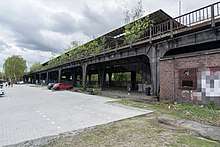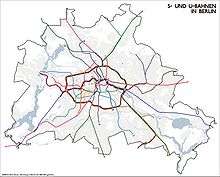Siemensbahn
Siemensbahn is an S-Bahn line in Berlin. It is named after the company "Siemens & Halske", which built the route independently between 1927 and 1929. It is almost four and a half kilometers long and has been out of service since the Reichsbahner strike in September 1980. There are plans to reactivate the route by 2025.

Description
The Siemensbahn starts at Jungfernheide station, where it is connected to the Ringbahn. From there it runs west and branches off at approximately the same height as the Ringbahn from the Hamburger Bahn. Unlike this, however, it takes the route north across the Spree and first reaches Wernerwerk station. After the station, it makes an extensive 90-degree angle, runs briefly to the west, where the Siemensstadt station is located (both in the district of Siemensstadt), and then to the northwest. After a good kilometer it reaches the terminus Gartenfeld in the locality of the same name. This was additionally equipped with an equestrian signal box and a six-track parking facility. Almost the entire length of the route is designed as a viaduct railway, only the terminus at Gartenfeld is at ground level. Its grounds and buildings have since been used by a garden center that has been abandoned since 2012.
History
In 1905, the Siemens group had its own train station set up for its employees so that they could get to work faster. The station opened on the Hamburg and Lehrter Bahn as Fürstenbrunn (later: Siemensstadt-Fürstenbrunn) initially had high passenger numbers, but was still unfavorable on the site. Since the factory center also moved to northern Siemensstadt in the 1920s, the factory management was looking for an alternative solution. In 1925 Siemens and the Deutsche Reichsbahn-Gesellschaft (DRG) agreed to build a new route.
The construction of the route and the equipment of the stations took over the Siemens Bauunion. The company provided the site. The Reichsbahn was only supposed to ensure operation. This arrangement was also possible because CEO Carl Friedrich von Siemens was also President of the Board of Directors of the DRG.
Construction began in 1927 and was completed in two years. On December 18, 1929, traffic began. The trains were electric, the great electrification of the Berlin city, ring and suburban railways was just in full swing. In the first few years the trains ran to Neukölln or Papestrasse. Passenger numbers rose significantly, with the route being largely used by workers at the Siemens plants. Of the roughly 90,000 employees that Siemens employed in Siemensstadt at the time, around 17,000 used the S-Bahn to and from their workplace every five minutes.
A development plan by Albert Speer provided for a transfer station at the end of the route. The route was damaged in the Second World War. So the Spree Bridge was destroyed just behind the junction. Already on September 17, 1945 it could be replaced by a makeshift bridge. At this point, the Siemens freight railway had already been provisionally connected to the Gartenfeld S-Bahn station via a wooden ramp, since the Wehrmacht had blown up the Spree Bridge. The second track was delivered to the Soviet Union as a reparation payment. Up to April 28, 1948, freight traffic took place predominantly in the night hours on the S-Bahn track. The connection remained until March 1950 because Siemens repaired S-Bahn cars for the Deutsche Reichsbahn.
The two-track operation was resumed on December 3, 1956 after the new Spree Bridge was built. The previous number of users was no longer achieved because the Siemens group had moved its headquarters to Munich. From then on, the route was one of the least used in the entire Berlin S-Bahn network. As a result, the trains were pulled back to Jungfernheide, and mostly older vehicles of the ET 168 and ET 165 series were used, which last ran every 20 minutes with 30 to 40 passengers.
Closing
After the Reichsbahner strike in September 1980, traffic was stopped. With the Siemensdamm and Rohrdamm stations on the U7 underground line, which opened in October 1980, Siemensstadt had an alternative to the Wernerwerk and Siemensstadt stations.
In August 1995, the section of the route between the district border to Spandau and the Gartenfeld station was listed. In 2005, when the Charlottenburg lock was built, the Spree was relocated, partially removing the railway embankment between the junction of the ring railway and the southern bank of the Spree and demolishing the foreland bridge of the Spree bridge. In 2007 the Berlin Senate objected to the deconstruction of the railway site requested by the Federal Railway Authority. Negotiations between the Deutsche Regionalale and Deutsche Bahn to take over the infrastructure between Wernerwerk and Gartenfeld were unsuccessful in 2008.
Since the decommissioning, Deutsche Bahn AG or the districts of Spandau and Charlottenburg-Wilmersdorf, in which the railway line runs, have carried out only a few maintenance works on the decaying and overgrown track systems, the substructure and the train stations. The Deutsche Bahn estimated its costs for securing the route at 500,000 euros annually. Later she estimated the effort for three years (2013-2015) to only 133,000 euros.
Reactivation and expansion plans
In 2014, the architect and lecturer at the Stuttgart University of Applied Sciences Rebecca Chestnutt-Niess worked with students to develop designs for subsequent use. The re-urbanization project of the Siemensbahn included the establishment of a swimming lane on a section of the route, the targeted greening of the viaduct and the setting up of a foot and cycle path. The proposals were issued in July 2014 at Halemweg 21, a former Schlecker branch.
The Siemensbahn is still included in the Berlin land use plan from November 2017. After that, it should also be possible to extend it beyond Gartenfeld via Daumstraße (Wasserstadt Oberhavel) to Hakenfelde. The route would run along the old Berlin-Spandau shipping canal, through the beaver protection area and parallel to Rhenaniastraße to a new Daumstraße station and then cross or cross the Havel to the new terminus at Hakenfelde on Streitstraße, south of the Goltzstraße intersection. In the course of the early public participation of the new building project "Neues Gartenfeld", the Senate Administration presented a line deviating from the land use plan: The Gartenfeld island would have been crossed underneath and the route north along the Rohrbruchtich to Daumstrasse would have been led. According to this planning, the Gartenfeld station would have to be relocated to the Gartenfeld island. How much the restart would cost has not yet been estimated.
After Siemens AG decided in October 2018 to build a campus in Siemensstadt for research purposes, the group and the Senate spoke out in favor of reactivating the Siemensbahn. In combination with the further expansion of the water city and the new construction of the island of Gartenfeld, the need to reactivate the Siemens Railway is increasing. The Berlin Senate wish to be reactivated by 2025, it said. The reconstruction was subsequently included in the i2030 transport project of the two federal states of Berlin and Brandenburg and the DB AG.
In November 2019, DB Netz AG tendered for the creation of a feasibility study for the second construction phase Gartenfeld - Hakenfelde across Europe. The study includes various route options for a two-track extension for a maximum speed of 100 km/h with the intermediate stops "Gartenfeld", "Wasserstadt Oberhavel" and "Hakenfelde".
Literature
- Bernhard Strowitzki: S-Bahn Berlin – Geschichte(n) für unterwegs. GVE-Verlag, Berlin 2002. ISBN 3-89218-073-3.
- Die neue Siemensbahn / Bahnhöfe Jungfernheide – Wernerwerk – Siemensstadt – Gartenfeld. In: Deutsche Bauzeitung, Jg. 63, 1929, S. 865–873.
